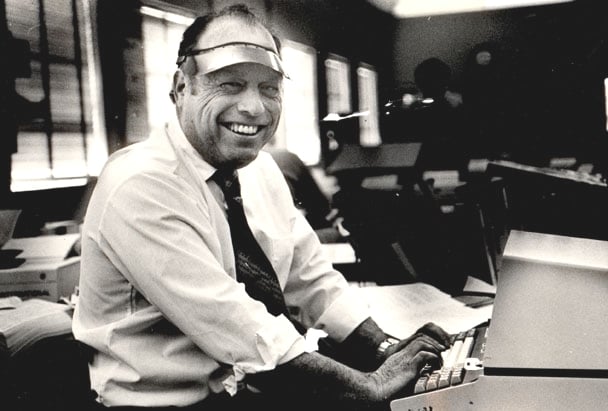This post from the Queen of Measurement Katie Paine is a direct response to an earlier post from Alex Slater, wherein the managing director of Clyde Group argued that the PR industry needs to get back to its media relations roots.
I recently read Alex Slater’s post claiming that media relations still matters.
I couldn’t help but recall the “good old days” of visor-clad editors (I was one, albeit sans visor) whom you could take to lunch, treat to a round of martinis, and be assured of good coverage.
If those memories appeal, take the rest of the day off, find a copy of “Hello Sweetheart, Get Me Rewrite!”, and indulge in an afternoon of nostalgia. IMO, you’ll have likely made just as big an impact on your client’s business as if you’d spent your day trying to woo that special journo.

Courtesy: Bill Ryan and downhold.org
It’s about focus
The problem today is that any PR agency or in-house department that doesn’t have a 360-degree laser focus on the customer (as opposed to the media) is about as viable as a big box retail store, and just as likely to survive.
Marketing technology, agile processes, and social media are doing to traditional PR what Amazon’s done to bookstores, what Airbnb’s done to hotels, and what Uber’s done to taxis. Today, data and technology enable customers to quickly get closer to any product or service they want to buy. At the same time, marketers can reach directly into the customers’ lives to influence their decisions, diluting or erasing altogether the impact of media.
And let’s face it: your board of directors cares a whole lot more about sales, new customers, and market share than it ever did about “impressions.”
And trust
It also doesn’t help that distrust of the media seems to be growing every day. After a year or more of hearing about “fake news,” it could be argued that skepticism is at an all-time high. And, when trust in media is evaporating, you need a bigger tool kit than the press release and a media list – especially when the line between propaganda and PR blurs more with each news cycle.
Thus, the effort that PR people put into getting into targeted media outlets may not matter one whit, if a carefully placed post from a trusted friend (or a competitor posing as one) can wipe out in a second all the good PR you’ve been getting.
And who’s got the influence
Then there’s the question of whether or not the media you are targeting are influencing anyone at all? Be honest: when was the last time you checked in with your target audiences to find out if those journalists and outlets on your “top tier” list are changing their minds? It’s a question astonishingly few agencies even bother to ask, let alone are able to answer.
The insidious reality is that far too many top tier media lists are based on purported (and frequently vastly exaggerated) reach numbers and the frequency with which the outlets cover you. Which of course produces a self-fulfilling, if defeating, result. To wit:
If you are judged on the number of placements you achieve, you are naturally going to go after those journalists most likely to cover you. But the problem is that your job as a communications employee is not to generate hits but to contribute to the organizational bottom line. Do you have any solid evidence that those media play a role in the path to purchase?
If you can’t make a direct connection between your favorite reporter and their ability to change opinions or behaviors, you’re wasting your time.
Read: Influence? What’s that?
But some would argue that there’s credibility in earned media that you don’t get from advertising. Are you sure? What’s fake to me may be influential to you. The point is this: is your potential customer persuaded enough by the story that they will act in the way you want them to?
Far too frequently, communications decisions these days get made based on management assumptions that probably predate the iPhone.
And using your data
I’m not sure why it is that communications leaders are so loathe to survey their target audiences to find out what really keeps them up at night, but there is an astonishing reliance on anecdotes and assumptions rather than data-driven decision making.
On the marketing side, if a media outlet is influential, it means it drives sales or market share, and they’d probably pay to advertise in it. If IR says an outlet is influential, it presumably has the potential to influence your investors. If Talent Acquisition says an outlet is influential, it means it is reaching the universe of people you want to recruit and, as a result, they’re applying for and filling jobs. Without evidence that the coverage secured by PR is impacting business decisions, it’s very hard to take PR’s recommendations seriously.
In reality, we could stand to learn a thing or two from the Russians and start applying the same data mining techniques and precision targeting of susceptible audiences.
Those techniques start with understanding what influences your target audiences.
PR needs to know what sources their stakeholders trust when they are in the research and consideration phases of their decision-making process.
Armed with that data, you can build a media list that has meaning, one that will produce impact and result in actual influence.
But all this means PR people will have to talk to salespeople, marketing folks, development and research teams (if they have one), and yes, maybe even customers and prospects to find out what problems they have and how you might solve them.
The solution for PR pros is not better relationships with the media. It is the data and analytics that so many of our peers denigrate. The agencies that have astutely folded in data analysis, social media, SEO, and content marketing skills are the ones enjoying the most success. And that’s not going to change.







